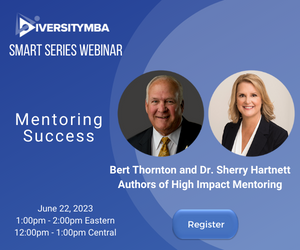by Patricia Pope
Pam McElvane: I’ve always been interested in your work on the Illusion of Inclusion. This has been a part of my experience. How did that get started?
Pat Pope: In the late 80s/early 90s, I began to notice that as some women and people of color began to be promoted to Director and VP levels, some tended to misinterpret their new title and position as meaning that they were now in the Inner Circle of Power and Influence in their organizations. Inevitably some situation would occur that let them know they weren’t where they thought they were, and that would always be a painful and somewhat humiliating experience as they would realize at that point that they were the only ones who had made that assumption….everyone else knew they weren’t included at that level.
Pam: I absolutely relate to this, so what did you do?

Pat: I got 5 different companies to allow me to interview director-level and up managers in their organizations. The purpose was to determine if women and people of color perceived inclusion in the same way as white males.
Pam: I could probably guess your findings, so tell me what did you find?
Pat: There was a distinct pattern across organizations based on race/ethnicity and gender that fell along a “continuum “from most to least “deluded” about their inclusion. White Females were the most susceptible to the “Illusion of Inclusion.” They had an incredible tendency to misinterpret the perception of them as hard working, reliable, dependable managers as meaning that they were in the inner circle of power and influence in their organizations.
The group right beneath them were Men of Color. They would say things like, “I call the CEO and he calls me back!” But when I asked if the CEO ever initiated a call to them, the answer was always “no.” So, the CEO’s appeared to be returning their calls simply because they didn’t want to be perceived as ‘racist.” If a white male at that same level had called the CEO, his call would not have been returned, and he may have been reprimanded for going outside the “chain of command.”
Then there was a big gap….to white males who basically know when they are “in” and know when they’re not. They get the signals, which of course, are the key, and know how to read them.
Finally, Women of Color were at the bottom and not at all “deluded.” They all said, “Well, I’ve never really felt that I “fit in” around here. Thus, they weren’t likely to delude themselves that they were in the Inner Circle of Influence!
White males revealed things in their interviews that I simply didn’t hear in any of the other interviews. For example, one white male said that he would often receive confidential internal communication that was distributed to only 4 or 5 managers in his department, and which said “for your eyes only” at the top. He recognized that only white males were on this list, and that women or minority managers in the department were never included. He asked the senior manager one day, “Why these people…referring to the 4-5 names who always appeared on the list?” The answer was, “Because these are the people whose opinions I value.”
Another white male told me that he and his family had been sent on an international assignment, and shortly hereafter, because of a personal family situation, he had to request that the company relocate him back to the US. He recognized that it was a huge expense to relocate a family outside of the US and asking to return less than 6 months later might derail his career. He said he asked what the consequences would be to his career and was told, “Don’t worry about it…..we take care of our own.”
There were consistent stories like this from white males that indicated that they were included and valued very differently compared to women and minorities at similar levels in these companies.
Pam: Interesting, so then what happened?
Pat: I went to grad school and was so intrigued by my initial findings that I wanted to continue to research it for my master’s Thesis. However, I wanted to find a better tool for measuring inclusion that would be more quantitative than interview data.
I found a methodology that enabled me to objectively measure inclusion at the “team level.” From my perspective, this was a huge breakthrough.

Pam: It absolutely was because I worked more effectively in a team environment. When I was a corporate executive., so what else was there?
Pat: Because up to this point, organizations were using survey tools that were all based on perceptions. If they sliced the data by race/ethnicity and gender, it typically showed the same results, i.e., white males were the most positive about their work experience, followed by white females and men of color, with women of color always being the least satisfied/positive.
When asked specifically about representation of women and people of color and their organization’s Affirmative Action efforts, white males typically thought the organization had gone overboard with these efforts and wondered when” enough would be enough.” On the other hand, women, and people of color were more inclined to wonder when the organization was going to get serious and stop paying lip service to these efforts.
Pam: So, you had two diametrically opposed views of this critical issue about inclusion!
Pat: That’s right. They were very polarized in their perceptions, with no ability to determine whose perceptions were more accurate. Most organizations felt “stuck.” If we do more, we risk alienating the white males who feel that the women and people of color are getting “special treatment” – but if we stop these efforts, we will be perceived as “not committed” by women and people of color.
Pam: So, what did you find with your master’s research?
Pat: Since I was using a team-based instrument, I sought senior level teams to participate in my research. Everyone on the team agreed to complete two survey parts. The first part measured objective inclusion, and the second part consisted of survey questions regarding each individual’s perceptions of their own inclusion.
I was able to correlate individual perception scores of their inclusion with their actual inclusion scores. Amazingly, for white males, 15 out of 16 correlations were statistically significant. Again, they KNOW when they are included and they know when they aren’t. For women and people of color, only 1 out of 16 correlated, thus proving that the “Illusion of Inclusion” was a very real phenomenon.
Pam: Wow! I can think back to my own experience and actually relate to your findings. So, what have you done with this tool and your research since then?
Pat: I’ve continued to refine the tool and have used it with a variety of different organizations and teams to help them look at dynamics of inclusion and exclusion that are operating on their teams, and have continued to conduct interviews with senior level executives to obtain more insight into what they perceive to be the real “signals” that let you know when you are included in the inner circle of power and influence.
The tool alone is a great way of measuring how well a team that is supposed to be working together is actually working together, i.e, What are the team strengths and deficiencies. We then slice the data based on the differences on the team that are most relevant for them.
Pam: What kinds of differences?
Pat: For one senior executive team who had gone through a merger the previous year, the most significant difference was whether an executive had come from former company A, former company B, or if they had come in “post merger.” I had to convince the CEO to allow me to slice the data this way, as he was concerned that they had worked so hard to overcome these barriers, that if the data showed they weren’t “there yet,” he wasn’t sure the team could handle it. My response was, “But you need to know, and this assessment will either validate that you’re there, and you can celebrate that, or it will show that you still have some work to do.” Fortunately, the results indicated that there were no barriers operating based on this difference.
Pam: I know that employee satisfaction surveys have been around for a long time, and now many organizations are doing employee engagement surveys. How is this tool different?
Pat: The problem that I see with most surveys is that the questions are totally transparent. Employees know exactly what you are looking for and make a decision about how candid they want to be. The other problem, from a diversity perspective, is that most of these surveys are sliced by department. Given that women and people of color are typically a minority in their organizations to begin with when you slice the data by department, their perceptions of satisfaction or engagement, which are often very different, get “lost” because they represent an even smaller number of employees in most departments. So, their experiences in the organization which are often very different because of their gender, race or ethnicity don’t surface. Eventually, they leave to go somewhere else, which is reflected in often higher turnover patterns for these sub-groups.
Or, if the data is sliced by race, ethnicity, gender and department, women and people of color may feel that they have very little anonymity. One African-American female in one organization told me that if she checked the boxes indicating her race, her gender, her level, and her department, she might as well write her name on the top of the survey. So she told me that she checked the box that said “white male” but after that, she was completely honest in her responses.
This tool is very different in that the questions aren’t transparent, and those completing the survey have no idea of how the data is going to be analyzed. In the current environment of “political correctness,” I think we need survey tools that aren’t so “transparent” in order to uncover what is really going on.
Pam: You referred earlier to the “signals” that indicate when someone is truly “included.” Can you share what some of the real signals of inclusion are?
Pat: The list continues to grow, but there are some themes that have been consistent, such as knowing about key changes before they are announced, having others, especially newcomers, referred to you as “someone you ought to know”; being asked to take on high visibility assignments; and being included in “closed door meetings” when important decisions are being made.
Pam: Thanks Pat.









